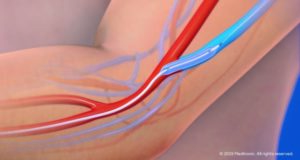
Just-published six-month results of the IN.PACT AV Access study show that drug-coated balloon (DCB) angioplasty is superior to standard angioplasty for the treatment of stenotic lesions in dysfunctional hemodialysis arteriovenous fistulas (AVFs). Furthermore, it was found to be non-inferior with respect to access circuit-related serious adverse events within 30 days.
These results were published on Aug. 19 in the New England Journal of Medicine (NEJM). Robert Lookstein, MD, of Mount Sinai Health System, New York, and colleagues note that long-term outcomes for standard percutaneous transluminal angioplasty (PTA)—the current recommended treatment for dysfunctional hemodialysis fistulas—are poor. DCBs delivering the antirestonotic agent paclitaxel may improve outcomes, they write.
In this prospective, single-blinded, 1:1 randomized trial, the investigators enrolled 330 participants across 29 sites in the U.S., Japan and New Zealand. Patients with new or restenotic lesions in native upper-extremity AVFs were eligible for participation.
After successful high-pressure PTA, participants were randomly assigned to receive treatment with either the IN.PACT AV drug-coated balloon (Medtronic) or a standard balloon.
Lookstein and colleagues detail that the primary effectiveness endpoint was target-lesion primary patency, defined as freedom from clinically-driven target revascularization or access-circuit thrombosis during the six months after the index procedure.
They assessed the primary safety endpoint—serious adverse events involving the arteriovenous access circuit within 30 days—in a noninferiority analysis (margin of noninferiority 7.5 percentage points).
Lookstein et al write that a total of 330 participants underwent randomization, with 170 assigned to receive treatment with a DCB and 160 assigned to receive treatment with a standard balloon.
Writing in NEJM, the authors report that, during the six months after the index procedure, target-lesion primary patency was maintained more often in participants who had been treated with a DCB than in those who had been treated with a standard balloon (82.2% [125/152] vs. 59.5% [88/148]; difference in risk, 22.8 percentage points; 95% confidence interval [CI] 12.8–32.8; p<0.001).
In addition, they found that DCBs were noninferior to standard balloons with respect to the primary safety endpoint (4.2% [7/166] and 4.4% [7/158], respectively; difference in risk, -0.2 percentage points, 95% CI -5.5–5; p=0.002 for noninferiority).
In the NEJM paper, Lookstein et al detail that there has been a wide adoption of continuous hemodialysis through autologous AVFs. However, this has been associated with a high incidence of dysfunction caused by vascular stenosis within the fistula circuit, leading to inadequate hemodialysis.
Lookstein and colleagues acknowledge some limitations of the present study. For example, they note that the DCB has a different appearance than a standard balloon, which made a double-blind trial design “unfeasible.” In addition, the investigators recognize that further studies will be required to evaluate the safety and effectiveness of DCBs for the treatment of central vein obstruction, in-stent restenosis, or arteriovenous graft stenosis, as they investigated only lesions in AVFs.
“Improvements in patency could potentially have significant benefits for patients, leading to longer periods of successful and uninterrupted dialysis, as well as reducing the use of catheter-based dialysis and the substantial incidence of adverse events associated with this type of dialysis.”
“We now have Level 1 evidence of a simple technology that is proven to be safe and effective at improving outcomes for patients with end-stage renal disease [ESRD] on hemodialysis,” Lookstein commented.
He continued: “This is the first U.S. Food and Drug Administration [FDA]-approved paclitaxel-based device since the controversy last year, which is a testament not only to the incredible results seen in this trial, but also the significant needs of this population.”












